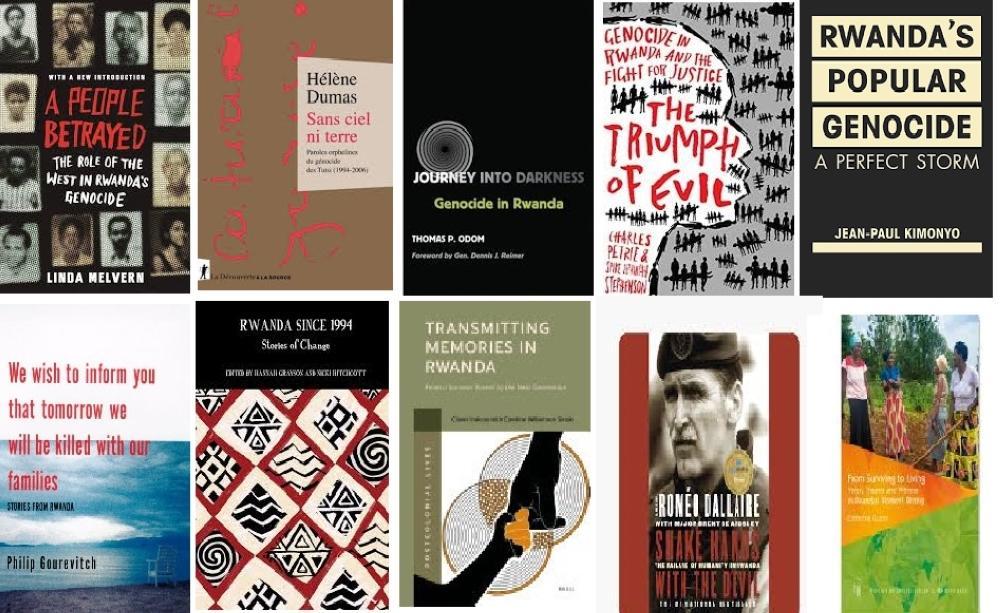Africa-Press – Rwanda. To truly understand the 1994 Genocide against the Tutsi and help combat genocide ideology, we compiled a selection of books that document the events, testimonies, and aftermath of one of the darkest periods in Rwanda’s history.
These publications, written by seasoned journalists, genocide survivors, scholars, and international observers, provide an understanding of how the genocide unfolded, the failures that allowed it to happen, and the resilience of those who lived through it.
1. Sans ciel ni terre, Paroles orphelines du génocide des Tutsi
Sans ciel ni terre, Paroles orphelines du génocide des Tutsi, loosely translated as “Without heaven or earth, orphaned words of the Tutsi genocide” is a French-language book written by Hélène Dumas, a research fellow in history at the National Centre for Scientific Research (CNRS). Her book captures the 1994 Genocide against the Tutsi through the eyes of child survivors.
Drawing from 2,000 notebooks written by 105 orphans aged between 8 and 12, the book recounts life before, during, and after the genocide, reflecting their raw memories and deep trauma.
Initiated by the association of genocide widows (AVEGA), in 2006, the writing exercise served as a form of testimony and a means of psychological healing for young survivors. The children wrote candidly about their past joys, their shock at being labelled Tutsi in school, and the brutal violence they endured or witnessed.
Some described themselves as “standing dead.” Their words, preserved in their original tone, reveal chilling scenes, families hunted with dogs, dehumanization by teachers and pastors, and intentional infection of girls with HIV/AIDS.
One excerpt recalls snakes becoming companions in hiding, offering safety when humanity failed them: “The snakes were our friends. We spent time in the holes they dug… We thought that we were related to them. They were good neighbours to us, while humans like us had abandoned us.”
2. A people betrayed: The role of the West in Rwanda’s genocide
Written by British journalist Linda Melvern, the book is an investigation into how Western governments failed to prevent the 1994 Genocide against the Tutsi. Based on 30 years of research and newly declassified archives, the revised and expanded edition includes updates, particularly new evidence from the 2022 trial of Félicien Kabuga, the financier of the genocide.
Melvern offers a revised chronology, a new section on the genocide’s build-up, and a supplement detailing six major genocide memorial sites and the massacres that occurred there. The book documents the genocide’s horrifying speed, scale, and intensity while exposing how international policymakers ignored warnings and obligations under international law. It also highlights the heroism of those who remained, including peacekeepers and NGO workers.
3. We wish to inform you that tomorrow we will be killed with our families
This book by American author and journalist Philip Gourevitch is a harrowing account of the genocide and its aftermath. Drawing on firsthand interviews and deep analysis, Gourevitch recounts how the Tutsi were murdered in 100 days following a state-led call to genocide. The title is taken from a letter written by a Tutsi pastor to his Hutu church president, foreshadowing the horror.
Gourevitch explores the psychological, political, and social impact of the genocide, portraying survivors, perpetrators, and those seeking justice. He captures the struggle to rebuild a society where victims and killers must live side by side, set against the backdrop of mass displacements, overcrowded prisons, and regional conflict. His detailed portraits and investigative narrative shed light on the resilience and contradictions within post-genocide Rwanda and broader postcolonial African politics.
4. Journey into darkness: Genocide in Rwanda
This book by a retired American intelligence officer, Thomas P. Odom, provides an insider’s perspective on the tragic events surrounding the 1994 Genocide and its aftermath.
In July 1994, Odom, part of the U.S. embassy team, witnessed the deaths of thousands of refugees in Goma, in eastern DR Congo, within a week during the refugee crisis that followed the genocide.
Drawing from his experience as a Defense Attaché and foreign area specialist in the U.S. Army, Odom offers a comprehensive account of the situation in Rwanda and the then Zaire, currently DR Congo, detailing the roles of U.S. embassies, intelligence operations, U.N. peacekeeping efforts, and regional responses.
Odom’s account highlights the intelligence and policy failures, illustrating the complexities of foreign intervention during such crises. Most importantly, it will give you an insider-kind of feel of what happened inside DR Congo as the genocidaires fled and re-organised to return to finish their genocide project in Rwanda. It will help you understand and connect the past and the present situation in the ongoing conflict in eastern DR Congo where genocide ideology continues to threaten regional peace and stability.
5. That child is me
Claver Irakoze’s book addresses the delicate task of explaining the 1994 Genocide against the Tutsi to children in a way that does not cause trauma.
Drawing from his own painful experiences as an orphan, Irakoze aims to guide parents on how to share their past with their children progressively and responsibly. The book includes illustrations and parts of his journey, encouraging curiosity and conversations without instilling anger or fear.
Irakoze stresses the need for positive human values and the role of parents in shaping their children’s understanding of the past, urging them to discuss difficult topics rather than remain silent. Through storytelling, he believes children can form strong emotional connections and develop empathy. Irakoze also shares his journey of survival, resilience, and recovery, expounding the power of education, values, and parenting in overcoming trauma.
6. The triumph of evil: Genocide in Rwanda and the fight for justice
This book by Charles Petrie offers a firsthand account of the genocide. Petrie, a United Nations official sent to assist in the region, documents how internal failures within the UN compromised its ability to respond.
He focuses particularly on the UN’s inability to protect its Rwandan staff, some of whom were murdered while waiting to be evacuated. Through detailed accounts and individual stories, the book shows how violence spread rapidly when hate was mobilized under an oppressive regime.
Petrie highlights how political interests and institutional weakness within the UN contributed to the scale of the killings and the failure to act.
7. Transmitting memories in Rwanda: From a survivor parent to the next generation
Also written by Claver Irakoze, the book traces the personal journey of an 11-year-old survivor of the genocide, who later faces the difficult task of parenting in a post-genocide society.
Set against Rwanda’s haunting history and resilience, the book navigates Irakoze’s life stages, exploring how trauma, memory, and identity shape both childhood and parenthood.
Through a mix of personal narrative and professional insight, Irakoze examines how memories of genocide are carried, processed, and passed on within families, especially to children born after the violence.
8. The Genocide against the Tutsi, and the Rwandan churches: Between grief and denial
This book by Philippe Denis offers a pioneering academic investigation into the role of Christian churches during and after the genocide.
Illustrated by interviews with survivors, clergy, exiles, and officials, along with church archives, Denis reveals how the Catholic and Presbyterian churches responded to the killings in just three months. While some church members sheltered Tutsi at great personal risk, others, including priests and pastors, supported the genocidal government and assisted perpetrators.
The book focuses on the Catholic Church’s involved internal dynamics and the Presbyterian Church’s 1996 confession of guilt. It also includes a case study of La Crête Congo-Nil parish, led by French priest Gabriel Maindron, who survivors claim did not oppose the violence.
By 1997, some Catholic leaders began shifting from a defensive to a more reflective posture.
9. From surviving to living: Voice, trauma and witness in Rwandan women’s writing
Catherine Gilbert explores how Rwandan women genocide survivors articulate their experiences through published testimonies. Focusing on texts primarily written in French, with some in English, the book examines how acts of extreme violence committed against women during the genocide are remembered, processed, and shared.
Drawing from trauma theory, Holocaust studies, and testimony criticism, Gilbert offers a close reading of individual and collective memory in post-genocide Rwanda. The book stresses ways survivors navigate trauma, memory, and voice, revealing the limitations of conventional Western frameworks in interpreting such narratives. By centering Rwandan women’s voices, Gilbert stresses the importance of listening differently, beyond traditional categories, to engage meaningfully with the realities of survival and the ongoing aftermath of trauma.
10. In Rwanda’s popular genocide: A perfect storm
Jean-Paul Kimonyo examines why large numbers of rural Hutu folk took part so directly in the genocide. Through a thoroughly researched social and economic history, Kimonyo analyzes grassroots power dynamics, political party influence, and the role of the state.
He explores how locally integrated relationships and socioeconomic pressures meet with the constructed ethnic divide. Despite the extensive literature on the genocide, the book offers new insights into its popular participation and underlying community-level dynamics.
11. Shake hands with the devil
Canadian Lieutenant-General Roméo Dallaire offers a traumatic account of his time as force commander of the UN Assistance Mission for Rwanda during the genocide. Tasked with supporting peace between warring groups, Dallaire instead witnessed the systematic massacre of more than one million Rwandans over 100 days.
With limited troops and dwindling international support, he managed to save thousands, yet his repeated pleas for reinforcements went unanswered. The book recounts not only the atrocities and political failures he encountered but also the profound personal toll they took on him.
Dallaire, who once saw himself as a confident cold warrior, details his descent into trauma and his battle with post-traumatic stress disorder. In sharing his experiences, he became the highest-ranking officer to speak so openly about such mental health struggles, offering a persistent inside view of one of the late 20th century’s darkest moments.
12. Rwanda since 1994: Stories of change
Authored by Hannah Grayson and Nicki Hitchcott, the book brings together a wide range of voices to examine Rwanda’s transformation over the past 25 years. Moving beyond reflective genocide scholarship, the volume explores the country’s evolving social, cultural, and political landscape through creative writing, testimonies, and academic analysis.
Contributors, spanning African studies, anthropology, education, law, and literature, consider how narratives of remembrance intersect with Rwanda’s national progress and regional developments in East Africa.
The book engages with the lived experiences of underrepresented groups, such as the Twa and children of perpetrators, while also noting shifts in religion and gender. Through interdisciplinary perspectives, it interrogates emerging frameworks for understanding change and the global forces influencing Rwanda’s trajectory.
13. Christianity and genocide in Rwanda
Timothy Longman examines how Rwanda’s rooted Christian institutions, despite the country’s majority Christian population, became central to the violence of the genocide. Drawing on extensive national and local research, Longman argues that Rwandan churches historically aligned themselves with the state and engaged in ethnic politics, eventually compromising their moral authority.
Focusing on two Presbyterian parishes in Kibuye, the book contrasts the efforts by progressive church members to democratize the institution with the actions of leaders who, like Hutu politicians, backed the genocide to protect their power.
Church buildings, instead of serving as sanctuaries, became killing grounds. Yet, the presence of individual Christians who resisted the genocide suggests that the churches had the potential to oppose the violence, an opportunity many leaders did not take.
14. Intent to deceive: Denying the genocide of the Tutsi
This is another book by Linda Melvern. It exposes a decades-long campaign to deny the 1994 Genocide.
Drawing on extensive government archives, including in Rwanda, Melvern details how genocide planners used disinformation as part of their strategy, both during and after the killings. The book traces how these perpetrators and their allies have since worked to reverse facts, spread false narratives, and manipulate research to distort the truth.
Their efforts have misled journalists, academics, and international audiences, posing a continued threat to historical accuracy and justice. Melvern stresses how denial deepens the trauma of survivors, whose lived experiences are ignored or erased by these falsehoods, and whose pursuit of justice remains unresolved.
15. Writing and filming the genocide of the Tutsi in Rwanda: Dismembering and remembering traumatic history
Alexandre Dauge-Roth explores how literature, survivor testimonies, and films confront the genocide. Through works like Hotel Rwanda, Sometimes in April, and African-authored novels, Dauge-Roth examines how these artistic forms bear witness to trauma and navigate the tension between collective memory and individual suffering. He analyses each medium’s strengths and limitations in making the unimaginable visible and engaging audiences unfamiliar with such experiences.
The book poses urgent questions about how survivors express their pain, how authors and filmmakers convey unspeakable violence, and how acts of witnessing shape our understanding of such trauma. Situated at the crossroads of Francophone and African studies, it states the difficulty and the vital importance of remembering the genocide through diverse forms of cultural expression.
For More News And Analysis About Rwanda Follow Africa-Press






